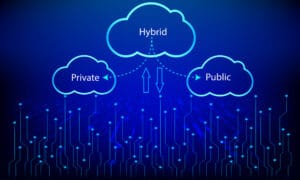
Hybrid cloud and microservices facilitate data integration and accessibility across environments, enabling faster deployment of applications and services.
Hybrid cloud feels like a generic buzzword these days, meaning different things to different people. However, if hybrid cloud is to become more than a buzzword and instead a valuable asset to an enterprise, CIOs and CTOs must understand the real-life benefits for their businesses. Further, they have to answer real questions about what a hybrid cloud approach will look like for their staff. What’s their current cloud structure? How should organizations deploy modern IT workloads? Which data and assets should be in a private cloud, public cloud, or on-prem? It’s time for enterprises to take a deeper look at what hybrid cloud actually means.
Addressing today’s challenges
Today, the number-one technical challenge for CIOs and CTOs is being able to deploy and shift workloads at any time. Legacy systems weigh down attempts to move at speed and optimize scale. Hybrid cloud is fast and convenient, allowing organizations to shift between public and private clouds and on-premises at lower costs and with reduced risks. Hybrid cloud architecture allows for leveraging the on-demand resource of the public cloud while still retaining sensitive and critical workloads privately or on-premises. It also allows IT leaders to take advantage of new technologies and digitally transform faster.
The conversations that IT leaders need to have around their cloud architecture is a conversation accompanied by many choices. Depending on staffing and resources, a CISO or CTO may opt for a managed cloud because it removes the need for IT staff to give daily support for cloud operations. A cloud service provider may be able to work more closely with an IT department to tailor a cloud solution specific to the organization’s scale, security, compliance, and data protection needs.
With today’s macroeconomic uncertainty, organizations need adaptive cloud technology to help manage unpredictability. With cloud, IT only needs to pay for what they use, and the entire organization can take advantage with lower levels of administration and support across devices. The security and reliability of cloud makes business continuity more certain and frees IT for tasks that add real value.
What’s driving hybrid cloud demand: containers and data
As containers and Kubernetes rose in prevalence, hybrid cloud did too. As of 2023, Gartner predicts that 15% of on-premises workloads will run in containers by 2026, up from 5% in 2022. The increase in adoption comes as organizations look to increase resource efficiency compared to traditional virtualization.
Think about how enterprises used to approach rapid change. Large core applications and their internal/external dependencies put a ceiling on the scale at which CTOs and CISOs could become adaptable. Because containers allow for granularity, composability, and flexibility, they help organizations keep pace with rapid change and support portability from on-premises to the cloud.
Containers ensure consistency in the development and deployment process. Because the same container can run in consistently in different environments, it greatly reduces the risk of errors caused by variations in the underlying infrastructure. In addition, containers are portable, which is critical to a hybrid cloud environment where workloads need to move seamlessly from on-premise to various cloud providers.
Containers also help to manage spikes in demand with small workloads that are virtualized, isolated, and secured. The ability to scale containers up or down rapidly helps ensure applications can handle workloads efficiently. Finally, containers and Kubernetes are great platforms for whatever comes next, such as cloud-native architectures, serverless, and Platform-as-a-Service.
See also: Hybrid Cloud Optimal For Businesses
Hybrid cloud delivers scalability and security
Today, we use data and analytics to achieve competitive advantage and to make smart, auditable decisions backed by facts. For example, the Canadian city of Brampton, Ontario, wanted to serve its citizens with better programs and services, so it created a comprehensive data management platform that delivers flexibility in IT and broader operations.
Brampton wanted to supply its government workers with all the tools they needed to make data-driven decisions and make its services easily accessible to its 650,000 residents, so the city leveraged data fabric and data analytics solutions. This made its transition to the cloud easier and ensured better access, value, and mobile device support from anywhere. This flexible hybrid cloud approach means the city can enjoy software, hosting, and support from a single, accountable source.
With its hybrid cloud infrastructure, government staff can more readily focus on how best to serve Brampton’s citizens across all services, like recreation, transportation, emergencies, and more. For example, now with reliable data and visual dashboards, Brampton can better manage recreation and leisure bookings and track bylaw infractions in real time, helping to support quick decision making and appropriate responses to citizen needs and risks.
How to get there
Getting to Brampton’s success isn’t easy for mature organizations that have hard-to-move critical workloads. We’ve moved away from the traditional “lift and shift” trend toward a pragmatic approach that brings application modernization to the top of importance. Adopting a hybrid cloud structure lets IT leaders create a bridge between traditional infrastructure and cloud technologies, which enables a deliberate migration to a more agile environment. That said, the pain is worth the return from moving to the cloud.
As organizations make this transition, it’s important to carefully consider cloud providers to avoid vendor lock-in. The ability to move from one public cloud to another is valuable. Also, consider the end user. To make IT’s lives easier in the long term, set aside a budget that allows them to create the environment that will work best for all types of users and require the least amount of IT oversight while keeping workloads secure and reliable.
Ultimately, the power of hybrid cloud is that it facilitates data integration and accessibility across environments, which increases collaboration for organizations. With faster deployment of applications and services, it enables IT to respond promptly to business demands. This allows IT to spend less time maintaining systems and more time solving big challenges and innovating for the future of the organization.




























